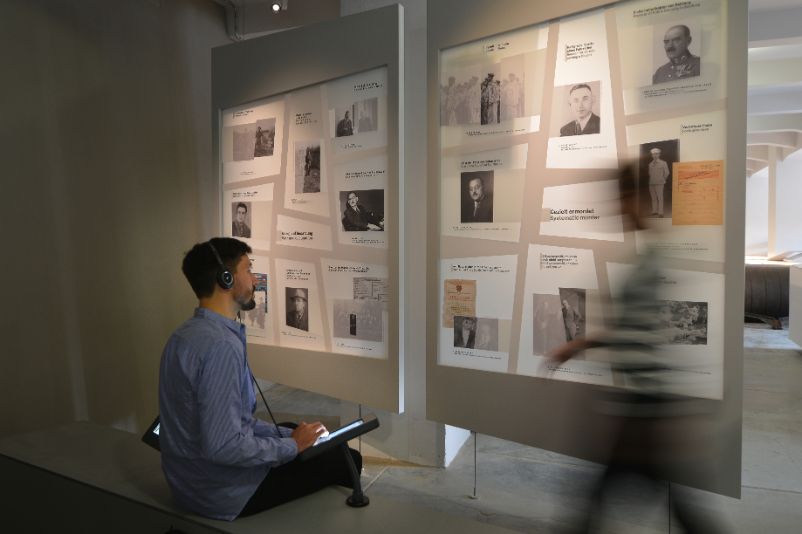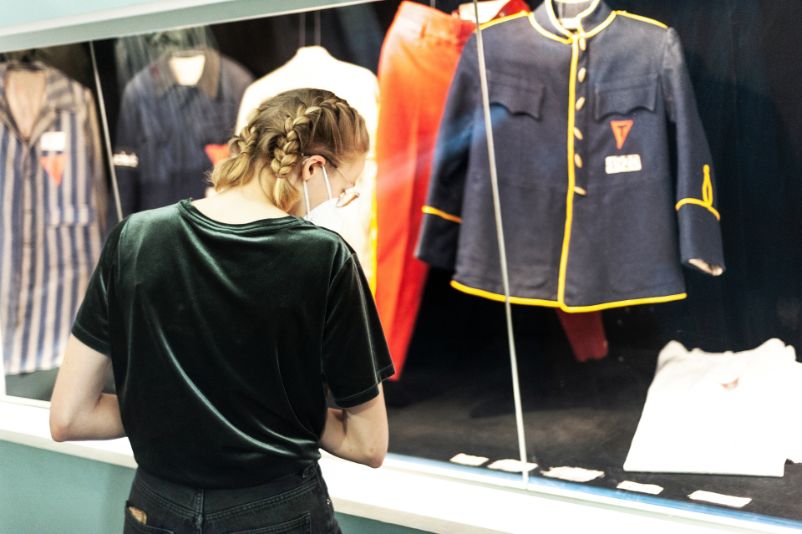
Design
The exhibition presents around 750 objects, over 400 documents and more than 1,300 photographs. There are also listening booths that bring together 85 biographical portraits and 25 personal memoirs of former inmates and recorder excerpts from various documents. Another 600 biographical annotations are found in different texts in the exhibition. More than 40 screens and projections in the exhibition show photographs, films, and interview sequences as well as quotations from former inmates.

Concept
The exhibition presents the history of the Buchenwald Concentration Camp as embedded in German society in the years 1937 to 1945 and especially details its connection to the city of Weimar. It thus spotlights the political and moral condition of this society; the attitudes and actions of institutions, authorities, companies, and individuals; the entanglements of the concentration camp with the outside world; and how people used the camp for their benefit in many ways. The concentration camp is shown to be a place that was not isolated nor invisible during in its time of operation.

Prologue
The prologue is an audio-visual animation which conveys, in distilled form, the historical phases and events behind the political, legal, and social transformation of Germany, from the transfer of power to Hitler and the National Socialist Party in 1933 to the building of the Buchenwald Concentration Camp in 1937.

Topics (Social Context)
At the heart of the exhibition, is a concise overview of the history of Buchenwald in Germany between 1937 and 1945. It is divided into four chapters and 17 themes, which bring together multiple elementary facets (68 in total) of the story in a modular way.
Vertically presented markers identify the different topics both visually and in terms of content. Each theme has an introductory text. All the texts focus on the essentials. To the greatest extent possible, they have been written in a way that does not require previous knowledge, enabling visitors to "jump right in" and engage with the exhibition.

Life Stories
Another aspect of the exhibition takes the form of six listening stations on inmates' lives and stories of persecution. The examples of 85 people illustrate the composition of the inmate community within the Buchenwald Concentration Camp. For the first time, all categories of victims persecuted on the basis of National Socialist ideology or in the wake of NS occupations are given a voice and a face, including the so-called "asocials" and "habitual criminals" persecuted on the basis of a socio-racist rationale.

Artifacts
The exhibition also comprises three cabinets of artifacts. As self-contained spaces devoted exclusively to the history of the victims, they use original objects from the camp or possessions of inmates to convey the overarching themes of depersonalization and uniformity, malnutrition, and hunger, but also self-assertion.

Information Modules
Two interactive, animated information modules in the exhibition offer additional information: one focussing on 139 subcamps of the Buchenwald Concentration Camp; another detailing the over 100 hundred sites and facilities – prisons, camps, and so on – from which people from all over Europe were deported by the Germans to the Buchenwald Concentration Camp between 1939 and 1945.

Epilogue
Like the prologue, the epilogue is also distinguished from the main section of the exhibition by its design. Nine spotlights outline the situation in the liberated Buchenwald Concentration Camp and shed light on its subsequent history, for example, how the National Socialist crimes were dealt with both legally and socially in West and East Germany, as well as the delays and limitations in confronting the crimes. In this final section, survivors speak themselves: as eyewitnesses of liberation; in testimony about the effects of the persecutions and crimes in the camp; and in reflections on the consequences that should be drawn from the history and experience of National Socialism.

